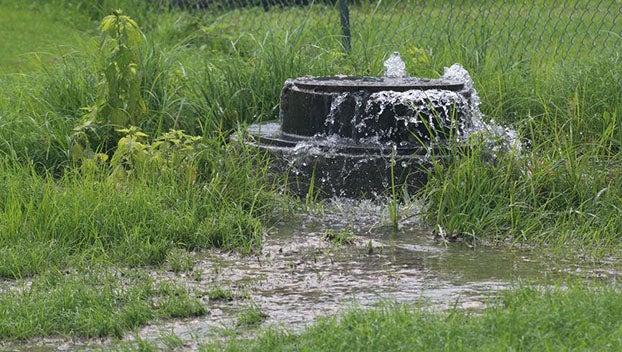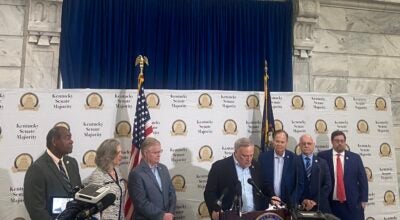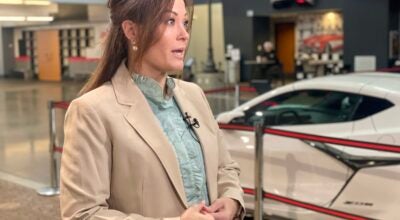‘You can’t imagine what’s in my yard’ — Kentucky community seeks millions to correct sewage problems
Published 5:42 am Friday, May 7, 2021
“It just hits you in the face.”
That’s how Hank Schweickart, a Coolbrook subdivision resident, described the awful odor he and his neighbors had to endure after raw sewage pushed above ground in his yard in August 2018.
The overflow issue stemmed from a lightning strike during a storm that damaged the sewer’s pump system and created an odor so awful that some residents opted to leave their homes until it cleared.
“You can’t image what’s in my yard,” Schweickart told the Franklin County Fiscal Court, adding that his son had been spending more time in the hog house because it smelled better than their home.
For the better part of two decades, local officials have been working to correct severe sewer issues in the Farmdale Sanitation District, which services Coolbrook and six other subdivisions in southern Franklin County.
Now, the fiscal court is seeking federal funding to install an interceptor sewer system, which would eliminate the need for six wastewater treatment plants and direct all wastewater to a centralized pump station and send it to the city for treatment.
The court submitted its request for Fiscal Year 2022 Appropriations Community Project Funding to U.S. Rep. Andy Barr, R-Ky., last month. The county is asking for $12 million. The total cost of the project is $14 million.
“We feel good that it’ll go through,” Judge-Executive Huston Wells told The State Journal, adding that the county has been working on the project with Barr for about six years.
Wells said there is the possibility of funds coming in via the American Rescue Plan Act (ARPA), a $1.9 trillion relief bill signed by President Joe Biden last month.
“Hopefully one or more of those pots of money will be used to get this project moving forward quicker,” he added.
The earmark money is still a question mark, Wells said.
Barr, who represents most of Central Kentucky and parts of Eastern Kentucky in Congress, ended up putting the Farmdale/U.S. 127 project among his top 10 projects for earmark consideration. However, localities will not know if funding is available for any earmarked projects, let alone their own, until fall. Wells said the schedule for selection for federal funding thereafter is unclear.
The problem
Farmdale Sanitation District serves 1,077 households, including all areas south of Interstate 64 to the Anderson County line and west of the Kentucky River that aren’t currently serviced by the City of Frankfort Sewer Department.
For sewer disposal, most Farmdale residents rely on either individual septic systems — some of which are in poor condition or failing due to soil conditions in the area not being conducive to conventional septic systems — or one of nine package wastewater treatment plants. Many of those plants have been cited for violations by the Kentucky Division of Water for not meeting discharge limits or bypassing sewage to local waterways.
The wastewater treatment plants owned by the Farmdale Sanitation District are Evergreen (10 houses, 12 apartments, five duplexes); Edgewood Subdivision (132 homes); Farmgate Subdivision (32 houses); Meadowbrook Subdivision (26 homes); Farmdale Subdivision (188 single-family units); Coolbrook Subdivision (429 residential connections); and Huntington Woods Subdivision (112 residential customers).
Privately owned wastewater treatment plants include Stewart Home and School, a residential facility, and H&M Mobile Home Park, a 12-unit mobile home park.
Magistrate Sherry Sebastian, who serves the Farmdale District, said she can attest to the health and safety concerns the aging wastewater treatment plants pose to her constituents.
“These plants suffer frequent outages due to outdated and failing equipment,” she wrote in a letter to Barr in support of the project.
“When the operation of package plants is interrupted, raw sewage seeps into residential yards and can flow into waterways, exacerbating health and safety concerns while introducing environmental issues and potential disease transmission,” Sebastian added.
According to the Franklin County Health Department, “many, if not all,” of the package wastewater treatment plants aren’t properly treating sewage on a consistent basis, which in turn leads to pollution.
In fact, portions of Benson Creek, which is located near most of Farmdale’s service district, have been determined to be impaired for aquatic life, according to a U.S. Environmental Protection Agency report. The suspected sources of the pollutants are septic systems that are being “straight piped” into local waterways and ineffective package wastewater treatment plants.
“The existing facilities are all over 35 years old and were generally inadequately maintained by previous owners. They are outdated and overburdened,” said Terri Bradshaw, president and CEO of Kentucky Capital Development Corp. “Completion of this project will relieve multiple, independent and often unsafe and unreliable sewer treatment systems.”
Sebastian said that she generally supported the goals that the sanitation district has set for itself. She acknowledged the hard work of the board members and added that the board’s current situation is a difficult one.
“They’re kind of walking a tightrope,” Sebastian said. “They’re trying to maintain aging, dilapidated systems, while they’re trying to look to the future of how we build this out so we don’t stay in the same situation that we’re in. But right now we know we can’t retrofit a lot of the seven package plants that they have.”
State Rep. Derrick Graham, D-Frankfort, penned a letter in support of the project praising its potential to replace unsafe sewer systems and to “make possible the extension of the system down the 127 Corridor for economic development.”
The project
The proposed sewer interceptor system would create a centralized transmission system to send sewage to the City of Frankfort for treatment — thanks to a resolution signed in March 2020 by both local governments.
“The sanitation district is going to pay ‘X’ amount of money to send sewer to the city,” Wells explained. “All maintenance on the system will be done by the sanitation district. They’ll have to maintain the lines and put in the lines.”
The project would also eliminate the need for the Coolbrook, Edgewood, Farmdale Subdivision, Evergreen, Meadowbrook and Farmgate wastewater treatment plants.
A $550,000 Kentucky Infrastructure Authority grant, which was awarded to the district, and the rest of an $873,000 Environmental Protection Agency 2010 Special Appropriations Project (SPAP) grant for planning and design documents, will fund the initial phase of the project.
The sanitation district also intends to apply for funding from agencies such as Rural Development, Community Development Block Grant, Clean Water State Revolving Fund and the U.S. Economic Development Administration.
The pros and cons
In addition to fixing the failing infrastructure, project advocates say that one of itsthe biggest project benefits will be the economic impact on the U.S. 127 South corridor once sewers are available.
“Franklin County is in great need of infrastructure to property for industrial and residential building,” said Farmdale Sanitation District Chairman Allan Alsip.
“There is a very limited amount of land available for industrial development and an extreme housing shortage, both of which have not allowed the local economy to grow despite interest in our area.”
In fact, the number of housing units in Franklin County increased by 73 from 2011 to 2019 — just 0.3%, according to Bradshaw. That rate is the slowest among neighboring counties. Owen and Henry each recorded over 100. Shelby County added 1,774 and Scott had tremendous growth with 3,607.
“That means 3,607 more homes, more families in Scott County that are eating out, that are shopping, buying gas and groceries if you have that many more homes in your county,” Bradshaw said.
Yet not everyone is convinced of the economic benefits of industrial and residential.
Franklin County environmental activist Chris Schimmoeller believes Farmdale should have access to safe and reliable sanitation.
“However, sewers to Farmdale should be sized to accommodate existing demand and not be a driver of sprawling development down (U.S.) 127 South,” she told The State Journal on Wednesday. “Sprawl degrades the environment, destroys unique places and drains local economies.
“Our community should prioritize extending sewers to closer densely populated areas like Forks of Elkhorn before risky extensions down (U.S.) 127.”
Magistrate Marti Booth, who serves part of the area along with Sebastian, once agreed with Schimmoeller but has since changed her tune.
“Originally I was against it because I didn’t want any more development out here,” Booth said. “… but now I’ve had a lot of complaints from my constituents, and I don’t know what to do or what to tell them.”
Booth said that she has a private sewer system in her neighborhood and now supports the project because she feels for those who don’t have the same convenience.
Wells acknowledged that there might be a concern of sprawl along U.S. 127, but said that he hoped a potential sewer expansion would encourage conversations about “smart” growth.
He said that that discussion about what that growth could look like would be an ideal subject for the upcoming comprehensive plan update. Wells called the road on the opposite side of the county, Versailles Road/U.S. 60, “a perfect example of how not to do it.”
“If you look at U.S. 60 to I-64 you have stoplight after stoplight after stoplight, and that’s because you had rapid growth,” Wells said. “I think this is an opportune time for us as a community to decide to grow in a way that doesn’t mean stoplights every 100 yards. The comprehensive plan and planning & zoning itself are key parts to making sure that as we grow it’s not just haphazard and all the growth happens in five years. It can be planned. If we do it that way, then we can all be involved.”
The schedule
Three key components of the project are due in May — 75% completion of preliminary design plans and specifications, and the construction funding application process and easement acquisition are slated to begin, according to the application submitted by the county.
The county intends to submit preliminary design plans and specifications of the project to the Kentucky Division of Water (DOW) in August and expects to receive review comments from the DOW the following month. Revised preliminary design plans and specifications will be sent to the DOW in October with approval predicted for November.
Once commitments from funding agencies are determined, easement acquisition can be completed. Officials believe that would likely be in January with advertising and bidding slated to occur in March.
Construction on the project, which will take approximately one year, would start in July 2022.






